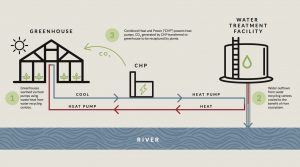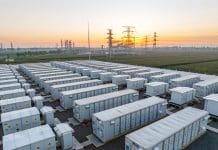Greencoat Capital has announced a £120m project to construct two of the UK’s largest greenhouses at farmland sites near Norwich and Bury St Edmunds
In a world-first, the advanced greenhouses will be warmed by residual heat from nearby water recycling centres owned by Anglian Water. Decarbonisation of the heating and agriculture sectors has so far been disappointingly slow despite their enormous carbon output. These pioneering greenhouses make a significant step towards solving both problems at scale, reducing the carbon footprint of food produce by 75% compared to European equivalents and increasing UK food security.
Electricity for the greenhouse’s heat pumps will be provided by a Combined Heat and Power (“CHP”) plant, with waste heat from the CHP providing further warmth for the greenhouses. The gas-fired CHP plant’s carbon emissions will be transferred into the greenhouses, raising the CO2 levels and further accelerating the growth of the plants, and capturing the majority of the carbon.
The construction phase of the project will begin immediately, with completion expected in autumn 2020. Commercial-scale growers from the UK and the Netherlands have already committed to leasing the space.
The greenhouses will provide ideal growing conditions for a range of plants and vegetables requiring a high-heat, and relatively low-light environments such as tomatoes, cucumbers and peppers. Once operational, the greenhouses will be capable of producing more than 1 in 10 of the country’s tomatoes and will create 360 permanent new jobs.
Greenhouses
The greenhouses are among the largest ever constructed in the UK with each covering more than 13 hectares – larger than the Millenium Dome (O2 Arena) at 10 hectares.
Standing around 7m tall the large glass structures allow crops to grow vertically along guidewires, and do not require any soil, instead of being grown hydroponically from nutrient-rich water solutions. Once in full production, they will be capable of growing more than 20 tonnes of tomatoes every day – 12% of the tomatoes grown in the UK.

Renewable Heat
Greenhouses are designed to capture and store solar radiation, thereby increasing air temperature and accelerating plant growth. In Europe, solar radiation alone cannot provide sufficient energy to reach optimal growing temperatures throughout the day, even in the summer. Most commercial greenhouses overcome this problem by using another heat source to increase temperature. This allows in-demand vegetables such as tomatoes to be grown year-round.
The majority of greenhouses use gas-fired boilers for this additional energy. Greencoat Capital’s unique approach largely displaces these fossil fuel emissions by using waste heat from Anglian Water’s nearby water recycling centres.
James Samworth, partner at Greencoat Capital, said: “We’re very pleased to have achieved another innovative first in the UK renewable energy sector. Technology and cross-sector co-operation is continuing to unlock some amazing possibilities in energy and agriculture. We see considerable opportunity to invest in renewable heat in the UK, providing pensions investors with the predictable returns they require to pay beneficiaries, meanwhile reducing our carbon emissions as an economy.”
Dr Lu Gilfoyle, head of environmental quality at Anglian Water said: “It has been great to be involved in such an innovative project, helping to solve a number of challenges for Anglian. Removing excess heat from the river systems is a priority for DEFRA and ourselves, and it is fantastic to be able to put that heat energy to good use.”
Andy Allen, director at Oasthouse Ventures, said: “Delivering a world-first low carbon greenhouse system is hugely exciting for the small team who took this from conception, design and planning, to contracting and now construction. The environmental, social and political benefits of these systems are significant, and we look forward to further disrupting the traditional carbon-heavy models of agriculture.”














